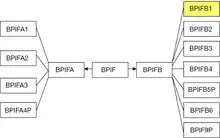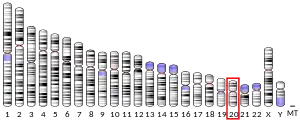| BPIFB1 | |||||||||||||||||||||||||||||||||||||||||||||||||||
|---|---|---|---|---|---|---|---|---|---|---|---|---|---|---|---|---|---|---|---|---|---|---|---|---|---|---|---|---|---|---|---|---|---|---|---|---|---|---|---|---|---|---|---|---|---|---|---|---|---|---|---|
| Identifiers | |||||||||||||||||||||||||||||||||||||||||||||||||||
| Aliases | BPIFB1, C20orf114, LPLUNC1, BPI fold containing family B member 1 | ||||||||||||||||||||||||||||||||||||||||||||||||||
| External IDs | MGI: 2137431 HomoloGene: 50047 GeneCards: BPIFB1 | ||||||||||||||||||||||||||||||||||||||||||||||||||
| |||||||||||||||||||||||||||||||||||||||||||||||||||
| |||||||||||||||||||||||||||||||||||||||||||||||||||
| |||||||||||||||||||||||||||||||||||||||||||||||||||
| |||||||||||||||||||||||||||||||||||||||||||||||||||
| |||||||||||||||||||||||||||||||||||||||||||||||||||
| Wikidata | |||||||||||||||||||||||||||||||||||||||||||||||||||
| |||||||||||||||||||||||||||||||||||||||||||||||||||
BPI fold-containing family B member 1 (BPIFB1) is a protein that in humans is encoded by the BPIFB1 gene.[5] BPIFB1 is a secreted protein, expressed at very high levels in mucosa of the airways (respiratory and olfactory epithelium) and salivary glands, and at moderate levels in the digestive tract (tongue, stomach, intestinal epithelium) and pancreas.[6]
Superfamily
BPIFB1 is a member of a BPI fold protein superfamily defined by the presence of the bactericidal/permeability-increasing protein fold (BPI fold) which is formed by two similar domains in a "boomerang" shape.[7] This superfamily is also known as the BPI/LBP/PLUNC family or the BPI/LPB/CETP family.[8] The BPI fold creates apolar binding pockets that can interact with hydrophobic and amphipathic molecules, such as the acyl carbon chains of lipopolysaccharide found on Gram-negative bacteria, but members of this family may have many other functions.

Genes for the BPI/LBP/PLUNC superfamily are found in all vertebrate species, including distant homologs in non-vertebrate species such as insects, mollusks, and roundworms.[9][10] Within that broad grouping is the BPIF gene family whose members encode the BPI fold structural motif and are found clustered on a single chromosome, e.g., Chromosome 20 in humans, Chromosome 2 in mouse, Chromosome 3 in rat, Chromosome 17 in pig, Chromosome 13 in cow. The BPIF gene family is split into two groupings, BPIFA and BPIFB. In humans, BIPFA consists of 3 protein encoding genes BPIFA1, BPIFA2, BPIFA3, and 1 pseudogene BPIFA4P; while BPIFB consists of 5 protein encoding genes BPIFB1, BPIFB2, BPIFB3, BPIFB4, BPIFB6 and 2 pseudogenes BPIFB5P, BPIFB9P. What appears as pseudogenes in humans may appear as fully functional genes in other species.
BPIFB1 was also identified as the LPLUNC1 gene (long-palate lung and nasal epithelium clone 1) in mouse,[11] but subsequently PLUNC proteins were classified as a subfamily of the BPI fold superfamily.[10] In a systematic analysis of the chicken genome, the Lplunc1(Bpifb1) / Lplunc5(Bpifb5) branch of the gene family was determined to be absent, therefore BPIFB1 and BPIFB5 proteins likely arose only after the speciation of mammals.[12]
Function
In mammals, the BPIFB1 protein is involved in the innate immune response to bacterial exposure in the mucosa of the mouth, nasal cavities, lungs, and digestive tract.[13] It has a role in sensing and responding to Gram-negative bacteria and contributes to anti-bacterial activity.
In humans it is abnormally expressed in a respiratory diseases such as cystic fibrosis (CF), chronic obstructive pulmonary disease (COPD), and asthma.[13] It is also differentially in tumors such as nasopharyngeal carcinoma (NPC), gastric cancer, salivary gland tumors, and lung cancer therefore BPIFB1 has been considered to be a therapeutic target for these conditions. For example, BPIFB1 expression is suppressed in NPC but when the gene is over-expressed in cell cultures and in mice, tumor cell migration and invasion (metastases) is reduced.[14]
References
- 1 2 3 GRCh38: Ensembl release 89: ENSG00000125999 - Ensembl, May 2017
- 1 2 3 GRCm38: Ensembl release 89: ENSMUSG00000027485 - Ensembl, May 2017
- ↑ "Human PubMed Reference:". National Center for Biotechnology Information, U.S. National Library of Medicine.
- ↑ "Mouse PubMed Reference:". National Center for Biotechnology Information, U.S. National Library of Medicine.
- ↑ "Entrez Gene: BPI fold containing family B, member 1".
- ↑ "Gene : BPIFB1 - ENSG00000125999". bgee.org. The Bgee suite: integrated curated expression atlas and comparative transcriptomics in animals. Retrieved 15 February 2023.
- ↑ Beamer LJ, Carroll SF, Eisenberg D (April 1998). "The BPI/LBP family of proteins: a structural analysis of conserved regions". Protein Science. 7 (4): 906–914. doi:10.1002/pro.5560070408. PMC 2143972. PMID 9568897.
- ↑ "CDD Conserved Protein Domain Family: BPI". www.ncbi.nlm.nih.gov.
- ↑ Beamer LJ, Fischer D, Eisenberg D (July 1998). "Detecting distant relatives of mammalian LPS-binding and lipid transport proteins". Protein Science. 7 (7): 1643–1646. doi:10.1002/pro.5560070721. PMC 2144061. PMID 9684900.
- 1 2 Bingle CD, Seal RL, Craven CJ (August 2011). "Systematic nomenclature for the PLUNC/PSP/BSP30/SMGB proteins as a subfamily of the BPI fold-containing superfamily". Biochemical Society Transactions. 39 (4): 977–983. doi:10.1042/BST0390977. PMC 3196848. PMID 21787333.
- ↑ Hou J, Yashiro K, Okazaki Y, Saijoh Y, Hayashizaki Y, Hamada H (February 2004). "Identification of a novel left-right asymmetrically expressed gene in the mouse belonging to the BPI/PLUNC superfamily". Developmental Dynamics. 229 (2): 373–379. doi:10.1002/dvdy.10450. PMID 14745963. S2CID 21625082.
- ↑ Chiang SC, Veldhuizen EJ, Barnes FA, Craven CJ, Haagsman HP, Bingle CD (March 2011). "Identification and characterisation of the BPI/LBP/PLUNC-like gene repertoire in chickens reveals the absence of a LBP gene". Developmental and Comparative Immunology. 35 (3): 285–295. doi:10.1016/j.dci.2010.09.013. PMC 3253384. PMID 20959152.
- 1 2 Li J, Xu P, Wang L, Feng M, Chen D, Yu X, Lu Y (May 2020). "Molecular biology of BPIFB1 and its advances in disease". Annals of Translational Medicine. 8 (10): 651. doi:10.21037/atm-20-3462. PMC 7290611. PMID 32566588.
- ↑ Wei F, Wu Y, Tang L, He Y, Shi L, Xiong F, et al. (January 2018). "BPIFB1 (LPLUNC1) inhibits migration and invasion of nasopharyngeal carcinoma by interacting with VTN and VIM". British Journal of Cancer. 118 (2): 233–247. doi:10.1038/bjc.2017.385. PMC 5785741. PMID 29123267.
External links
- Human BPIFB1 genome location and BPIFB1 gene details page in the UCSC Genome Browser.
Further reading
- Larocque RC, Sabeti P, Duggal P, Chowdhury F, Khan AI, Lebrun LM, et al. (April 2009). "A variant in long palate, lung and nasal epithelium clone 1 is associated with cholera in a Bangladeshi population". Genes and Immunity. 10 (3): 267–272. doi:10.1038/gene.2009.2. PMC 2672110. PMID 19212328.
- Zhang B, Nie X, Xiao B, Xiang J, Shen S, Gong J, et al. (September 2003). "Identification of tissue-specific genes in nasopharyngeal epithelial tissue and differentially expressed genes in nasopharyngeal carcinoma by suppression subtractive hybridization and cDNA microarray". Genes, Chromosomes & Cancer. 38 (1): 80–90. doi:10.1002/gcc.10247. PMID 12874788. S2CID 24805514.
- Bingle CD, Seal RL, Craven CJ (August 2011). "Systematic nomenclature for the PLUNC/PSP/BSP30/SMGB proteins as a subfamily of the BPI fold-containing superfamily". Biochemical Society Transactions. 39 (4): 977–983. doi:10.1042/BST0390977. PMC 3196848. PMID 21787333.
- Bingle CD, Craven CJ (April 2002). "PLUNC: a novel family of candidate host defence proteins expressed in the upper airways and nasopharynx". Human Molecular Genetics. 11 (8): 937–943. doi:10.1093/hmg/11.8.937. PMID 11971875.
- Bingle CD, Wilson K, Lunn H, Barnes FA, High AS, Wallace WA, et al. (May 2010). "Human LPLUNC1 is a secreted product of goblet cells and minor glands of the respiratory and upper aerodigestive tracts". Histochemistry and Cell Biology. 133 (5): 505–515. doi:10.1007/s00418-010-0683-0. PMC 2852594. PMID 20237794.
- Bingle L, Wilson K, Musa M, Araujo B, Rassl D, Wallace WA, et al. (November 2012). "BPIFB1 (LPLUNC1) is upregulated in cystic fibrosis lung disease". Histochemistry and Cell Biology. 138 (5): 749–758. doi:10.1007/s00418-012-0990-8. PMC 3470695. PMID 22767025.
- Shin OS, Uddin T, Citorik R, Wang JP, Della Pelle P, Kradin RL, et al. (November 2011). "LPLUNC1 modulates innate immune responses to Vibrio cholerae". The Journal of Infectious Diseases. 204 (9): 1349–1357. doi:10.1093/infdis/jir544. PMC 3182310. PMID 21900486.
This article incorporates text from the United States National Library of Medicine, which is in the public domain.



